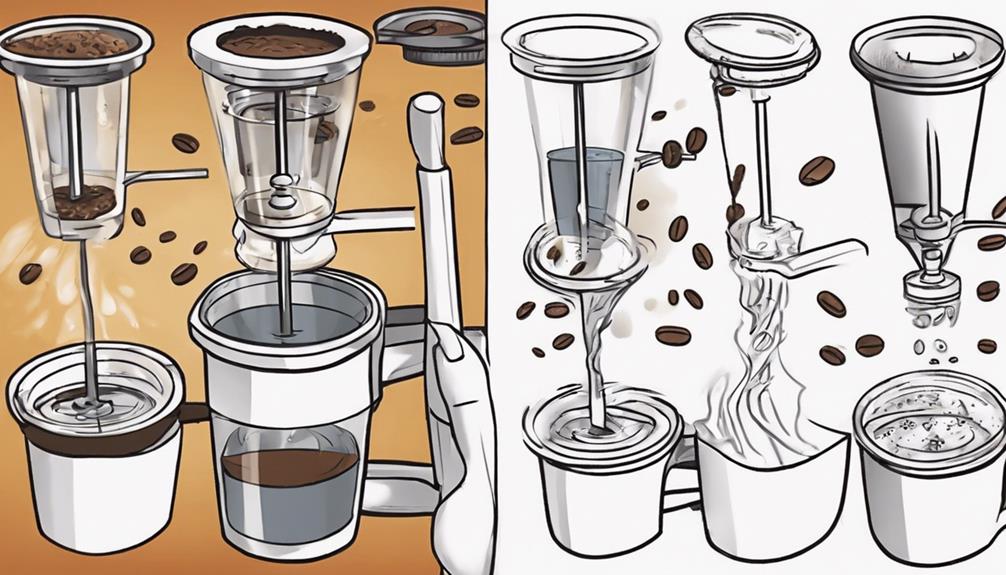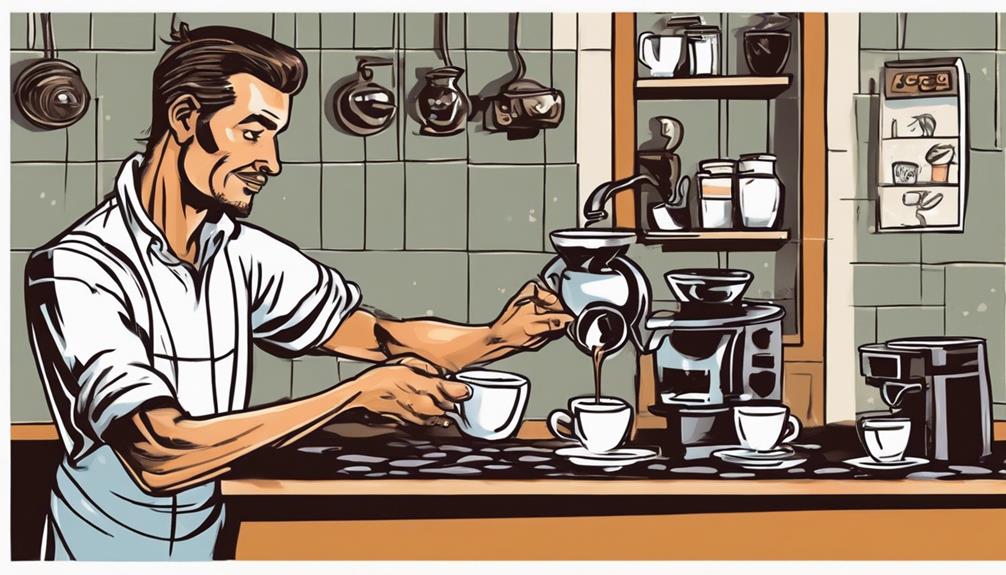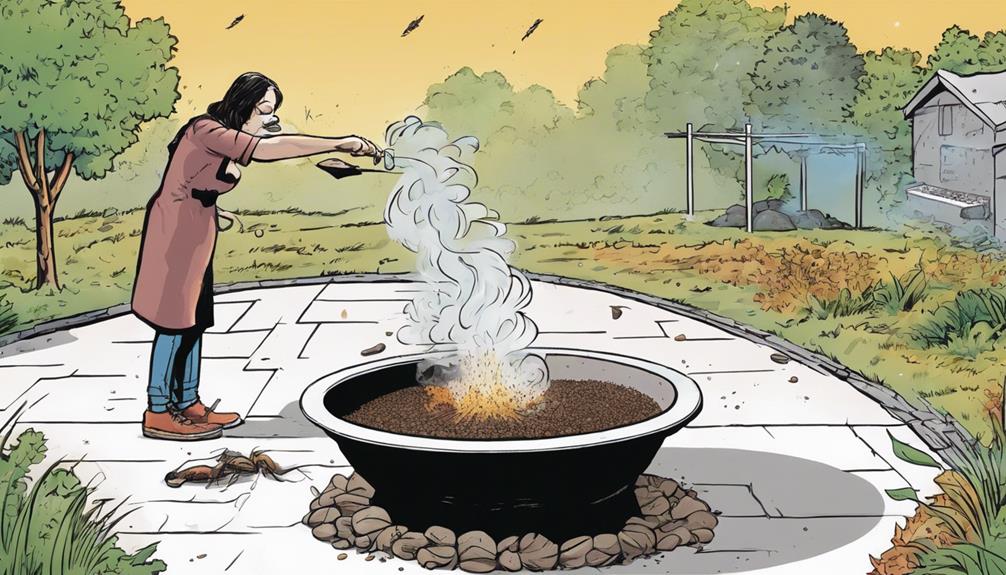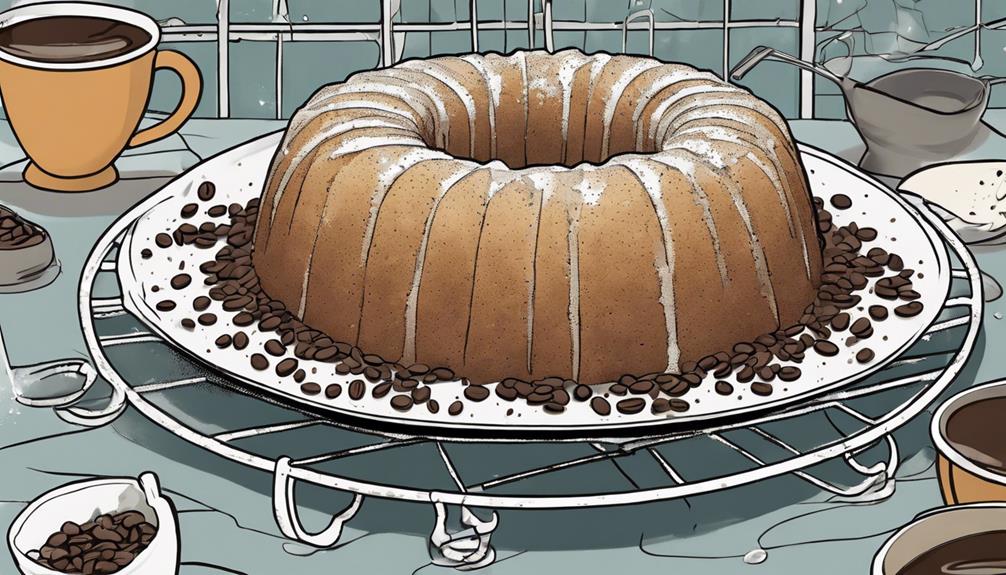For a bolder coffee taste, try brewing your coffee for a longer period than usual. This technique helps draw out more intense flavors from your coffee grounds, producing a rich and satisfying cup. By allowing the brewing process to extend, you will elevate the overall complexity of the flavor and provide your taste buds with a more luxurious experience. Some coffee aficionados also suggest using a coarser grind when prolonging the brew time for a stronger flavor profile. This enables better extraction without over-extraction, resulting in a well-balanced and full-bodied cup of coffee. If you prefer a more traditional approach, consider brewing coffee in a pot on the stovetop for a hands-on way to achieve a stronger coffee flavor.
Key Takeaways
- Extend brewing time for bolder flavor extraction.
- Prolonged brewing enhances richness and depth.
- Longer steeping intensifies complexity.
- Enhance strength with extended brewing.
- Achieve a robust taste by brewing longer.
Coffee Bean Selection
When selecting coffee beans for brewing, consider the flavor profile you desire and the strength you aim to achieve. Arabica beans are renowned for their smooth, nuanced flavors, while Robusta beans offer a bolder, more robust taste.
If you prefer a stronger coffee, blending in a higher proportion of Robusta beans can intensify the brew. The roast level also plays an important role in determining the flavor compounds present in your cup. Lighter roasts tend to preserve the beans' original flavors, while darker roasts can bring out richer, caramelized notes.
Moreover, the grind size of the coffee beans is essential for flavor extraction. Different brew methods, such as espresso or French press, require specific grind sizes to achieve best results.
Experimenting with various coffee bean types and blends allows you to tailor the strength and flavor profile of your coffee to your liking. Always remember that freshness is key to maximizing the full potential of your coffee beans during the brewing process.
Grinding Techniques
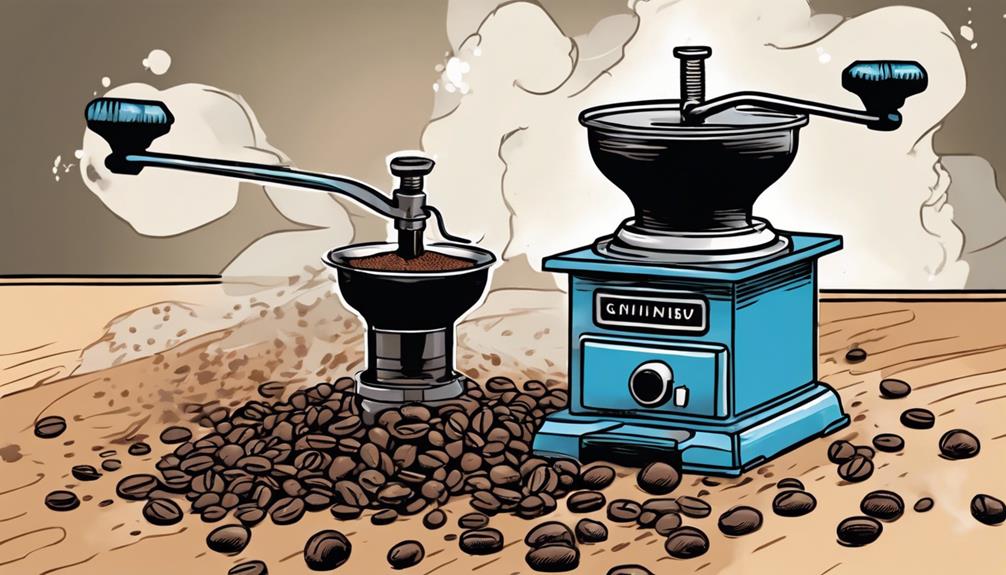
Consider how grinding techniques impact the flavor extraction process when preparing your coffee. The grind size plays a pivotal role in determining the strength and taste of your brew.
For instance, different brewing methods like French press require coarser ground coffee to achieve best flavor extraction, while medium grinds work well with flat-bottom filters and medium-fine with cone-shaped ones.
Investing in burr grinders can guarantee a more consistent grind size, leading to uniform extraction and enhanced flavor in every cup. Remember, freshly grinding your coffee beans just before brewing is key to preserving the prime flavor profile by avoiding oxidation and staleness.
Brewing Equipment Essentials
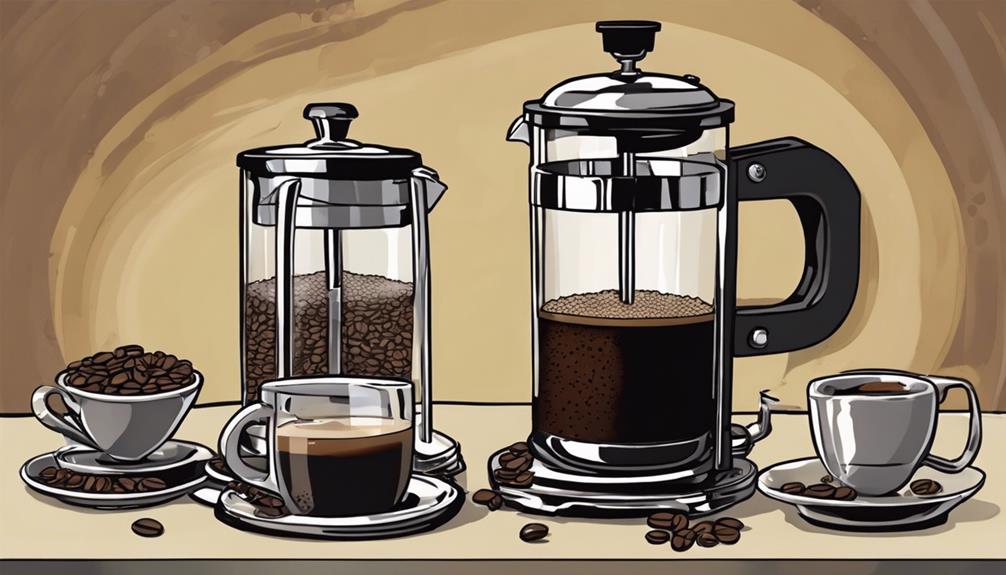
When it comes brewing equipment essentials, there are key tools that can make a significant difference in your coffee brewing experience. Understanding the basics of brewing gear and having the right equipment guide can elevate the quality of your brew.
Make sure to ponder the essential tools that will help you achieve the desired coffee strength and flavor profile.
Brewing Gear Basics
For efficient coffee preparation at home, necessary brewing gear includes drip coffee makers. These brewing devices play a crucial role in controlling water temperature, a key factor for extracting the best flavors from your coffee grounds.
Adjustable brew strength settings on modern coffee makers allow you to customize the intensity of your brew to suit your taste preferences. Additionally, some advanced models come equipped with pre-infusion features, which can improve the extraction process by saturating the coffee grounds before brewing begins.
Filter types also greatly impact the strength and richness of your coffee, with options like paper, metal, or cloth filters offering different results. Understanding these basic elements of brewing gear is important for achieving a delicious and personalized cup of coffee at home.
Essential Equipment Guide
Explore the vital brewing equipment needed to elevate your coffee brewing experience at home. When aiming for a stronger flavor in your coffee, the right brewing equipment can make a significant difference. Consider the following key elements when selecting your brewing gear:
| Brewing Equipment | Water Temperature Control | Pre-Infusion |
|---|---|---|
| Filter Type | French Press | Moka Pots |
| Pour-Over Devices |
Drip coffee makers provide convenience with adjustable strength settings, while incorporating water temperature control and pre-infusion features can enhance flavor extraction. The type of filter used in your brewing equipment also plays a pivotal role in achieving your desired coffee strength. Brewing tools like French press, Moka pots, and pour-over devices offer unique brewing experiences that impact the strength and flavor profile of your coffee. Understanding these equipment essentials is key for coffee enthusiasts looking to brew longer for a stronger coffee flavor.
Key Brewing Tools
Discover the necessary brewing tools that are indispensable for achieving peak flavor and strength in your extended brews.
- French Press: Ideal for extended brews, this tool allows for full immersion brewing, resulting in a rich and robust coffee flavor.
- Cold Brew Maker: Perfect for preparing cold brew concentrate that can be diluted for a longer, invigorating coffee experience.
- Immersion Dripper: Offers a controlled brewing process, allowing for a longer extraction time and a more full-bodied coffee profile.
- Burr Grinder: Essential for achieving a consistent grind size, which is vital for maximizing the flavor potential of your extended brewed coffee.
For a successful extended brewing experience, make sure you also have the following key tools: scales for precise measurements, timing devices to monitor steeping time accurately, and a quality water kettle with temperature control to maintain the ideal brewing conditions throughout the process.
Using these necessary brewing tools will elevate your coffee-making routine to new heights of flavor and satisfaction.
Coffee-to-Water Ratio Tips
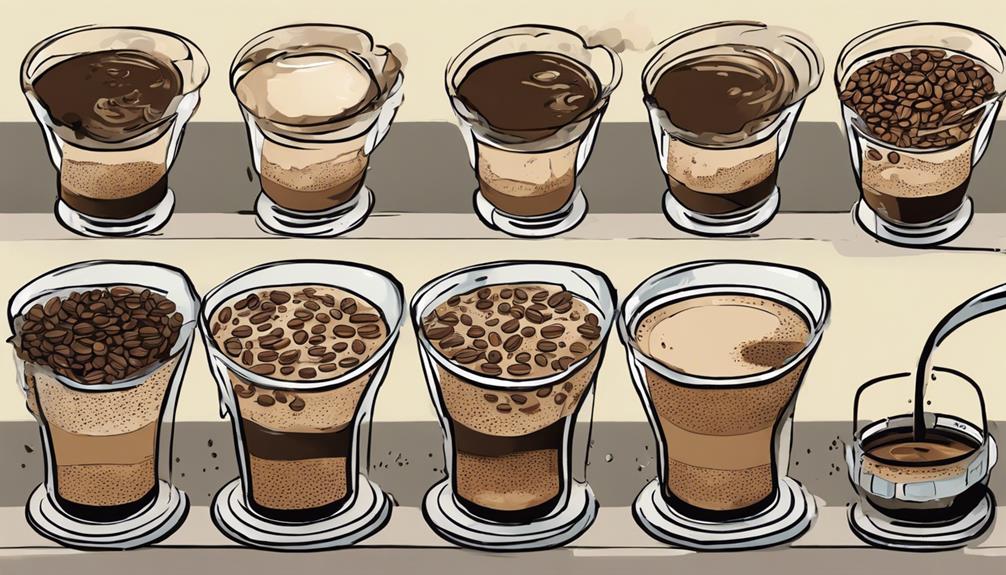
When brewing coffee, getting the coffee-to-water ratio right is key for a flavorful cup. Experimenting with different ratios can help you find the perfect balance for your preferred strength.
Understanding how this ratio impacts your brew will lead to a more satisfying coffee experience.
Ratio Importance
Maintaining the correct coffee-to-water ratio is crucial for achieving the desired strength and flavor in your brew. The brew ratio, determined by the amount of coffee grounds used in relation to water, directly impacts the extraction process.
To make the most of your coffee-to-water ratio, consider the following tips:
- Use the recommended ratios: Aim for a ratio between 1:15 to 1:17 to ensure peak extraction and a well-balanced flavor profile.
- Invest in a digital scale: Accurate measurements with a scale help achieve consistency in your brew, leading to a reliable strength and taste.
- Adjust to your taste: Feel free to tweak the ratio based on your personal preferences. Experimentation can lead to a customized cup of coffee tailored to your liking.
- Consider water quality: The type and temperature of water used also influence the final taste of your brewed coffee. Pay attention to these factors for a superior overall brew experience.
Experimenting With Ratios
To enhance your coffee brewing experience, experimenting with different coffee-to-water ratios can lead to a more personalized and flavorful cup. The ratio of coffee to water plays an important role in the brewing process, influencing the strength and taste of your coffee.
Start by using a digital scale to measure your coffee accurately. Recommended ratios typically range from 1:15 to 1:17 for best extraction, but feel free to experiment with different ratios to find what suits your taste preferences best.
If you prefer stronger coffee, begin with a 1:18 ratio and gradually adjust by adding more coffee grounds. This adjustment can make your coffee bolder and more robust. By varying the coffee-to-water ratio, you can control the intensity of your brew without changing the brew time.
Finding the right balance is crucial for creating a cup of coffee tailored to your unique preferences. So, grab your scale, start experimenting with ratios, and enjoy the process of discovering your perfect brew strength.
Optimal Brew Strength
For achieving a perfect brew strength in your coffee, mastering the ideal coffee-to-water ratio is vital. To enhance the flavor and strength of your brew, consider the following tips:
- Best Ratios: The best coffee-to-water ratio for a stronger brew typically ranges from 1:15 to 1:17.
- Digital Scale Precision: Using a digital scale for precise measurements ensures consistency in coffee-to-water ratios.
- Adjusting for Taste: Adjusting the coffee-to-water ratio can impact the strength and flavor of the final brew, allowing customization based on personal preferences.
- Water Quality Matters: Remember that water quality and temperature are essential factors that influence the strength of the brewed coffee.
Prolonged Brewing Process

Enhancing the flavor profile of your coffee, prolonged brewing involves extending the brewing time beyond the standard duration to achieve a bolder and more intense brew. By prolonging the brewing process, you allow for a more thorough extraction of flavor compounds from the coffee grounds, resulting in a stronger flavor. Extending the brewing time beyond the usual can lead to a robust and more pronounced taste that many coffee enthusiasts appreciate.
During prolonged brewing, the slow extraction process plays a pivotal role. This slow extraction enables the coffee to release more of its flavor into the liquid, creating a richer and more complex brew. Methods like cold brew or immersion brewing facilitate extended contact between the coffee and water, enhancing the depth of the final cup.
One significant advantage of prolonged brewing is the ability to adjust the brewing time to suit your preferences. By experimenting with different brewing times, you can tailor the strength and flavor profile of your coffee to your liking, ultimately achieving a more satisfying and flavorful cup.
Enhancing Flavor Extraction
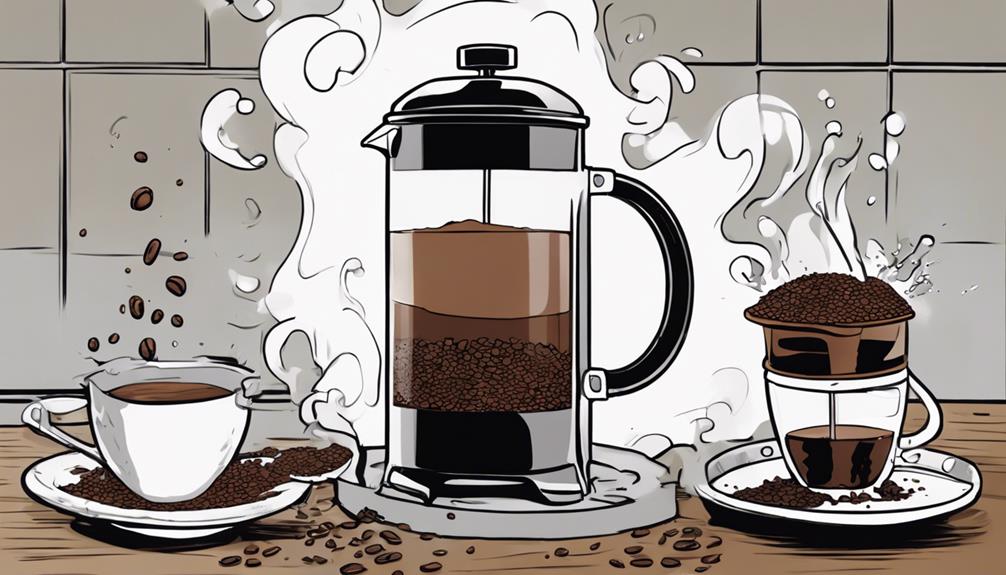
Longer brewing times enhance the extraction of flavors from the coffee grounds, intensifying the richness and depth of your brew. By extending the brewing time, you can reveal a more robust and intricate flavor profile, elevating your coffee experience to new heights.
- More Flavor Extraction: Longer brewing times allow for increased extraction of flavors from the coffee grounds.
- Intensified Richness: Extending the brewing process can intensify the richness and depth of the coffee, creating a more satisfying cup.
- Enhanced Strength and Complexity: Increasing the brew time enhances the strength and complexity of the coffee flavor profile, offering a more nuanced taste.
- Bolder Taste: Allowing the coffee to steep for an extended period can lead to a bolder and more robust taste that's sure to awaken your senses.
Frequently Asked Questions
How Do You Intensify Coffee Flavor?
To intensify coffee flavor, increase the coffee-to-water ratio, extend brewing time, experiment with grind sizes, and use fresh, high-quality beans. Consider cold brew for a longer steeping process. These steps will help you achieve a stronger and more robust coffee flavor.
Does Brewing Coffee Longer Make It Stronger?
Brewing coffee longer doesn't necessarily make it stronger; it can lead to bitterness from over-extraction. Adjusting grind size and coffee-to-water ratio is more effective. Aim for 4-6 minutes for a balanced, strong flavor without the bitter bite.
How to Make Brewed Coffee Stronger?
To make your brewed coffee stronger, try increasing the brewing time. Let those grounds steep a bit longer for a bolder flavor. You'll notice a richer, more intense taste without adding any extra bitterness. Customize your coffee strength to suit your preferences!
How Do You Extract More Flavor From Coffee?
To extract more flavor from coffee, increase the brewing time. This intensifies the strength and richness of your brew, enhancing its depth and complexity. Adjusting the steeping duration is essential in crafting a bold, pronounced taste.
Conclusion
To wrap up, by following these tips for a longer brew, you can achieve a richer and more robust coffee flavor that will satisfy even the most discerning coffee connoisseur. Another way to achieve a longer brew is by using the coffee pot brewing method. This method involves letting the coffee steep for a longer period of time before pouring it into your cup. By allowing the coffee to steep, you are able to extract more of the flavor from the grounds, resulting in a bolder and more intense coffee. With these tips and the coffee pot brewing method, you can elevate your coffee brewing skills and impress any coffee connoisseur. Additionally, brewing coffee in a pot allows for more control over the brewing process, as you can adjust the steeping time and temperature to suit your taste preferences. This method also works well for making larger batches of coffee, making it perfect for entertaining guests or for enjoying multiple cups throughout the day. Overall, using the coffee pot brewing method is a great way to achieve a longer brew and unlock the full potential of your coffee beans.
Remember, Rome wasn't built in a day, and neither is a perfect cup of coffee.
So take your time, experiment with different techniques, and enjoy the process of crafting the perfect brew to suit your taste preferences.
Happy brewing!

